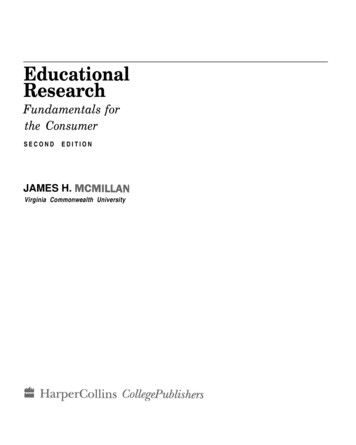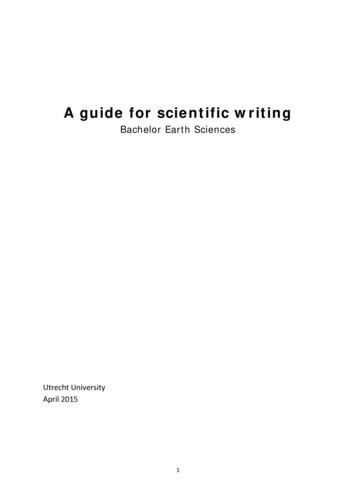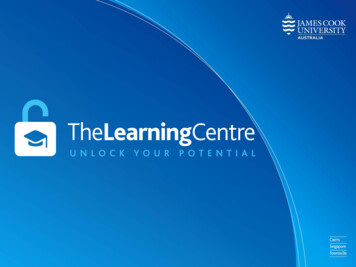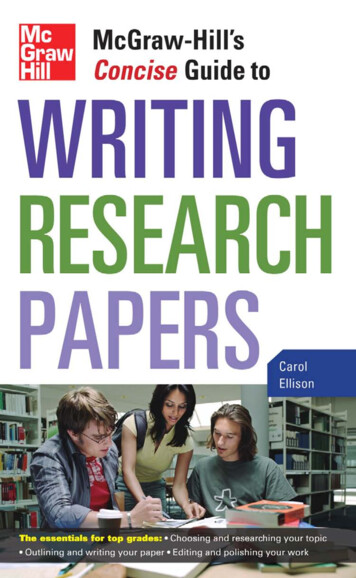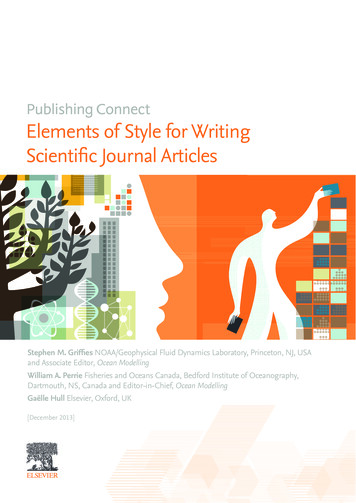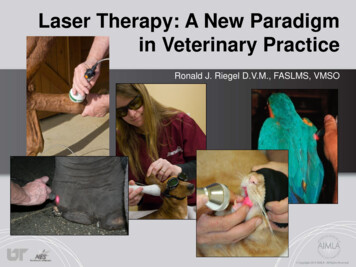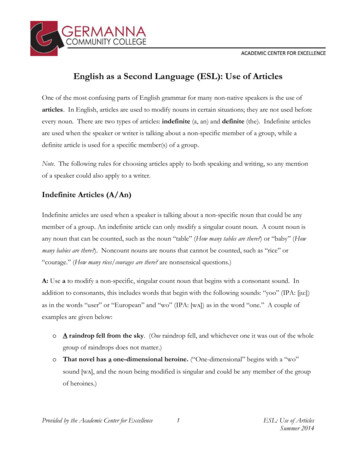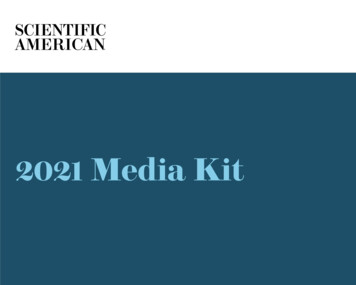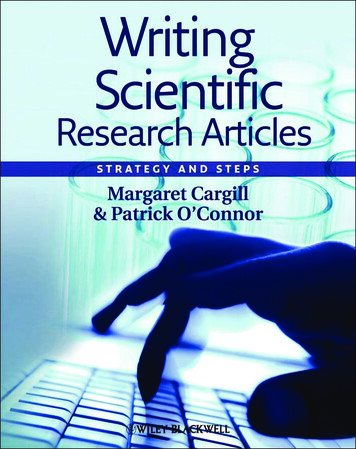
Transcription
Writing Scientific Research Articles
Writing ScientificResearch ArticlesStrategy and StepsMargaret Cargill and Patrick O’ConnorMargaret Cargill BA, DipEd, MEd (TESOL)Adjunct Senior LecturerSchool of Earth and Environmental SciencesThe University of AdelaideSouth Australia 5005AustraliaPatrick O’Connor BSc, PhDVisiting Research FellowSchool of Earth and Environmental SciencesThe University of AdelaideSouth Australia 5005AustraliaA John Wiley & Sons, Ltd., Publication
This edition first published 2009, # 2009 by Margaret Cargill and Patrick O’ConnorBlackwell Publishing was acquired by John Wiley & Sons in February 2007. Blackwell’s publishingprogram has been merged with Wiley’s global Scientific, Technical and Medical business to formWiley-Blackwell.Registered officeJohn Wiley & Sons Ltd, The Atrium, Southern Gate, Chichester, West Sussex, PO19 8SQ, UKEditorial offices9600 Garsington Road, Oxford, OX4 2DQ, UKThe Atrium, Southern Gate, Chichester, West Sussex, PO19 8SQ, UK111 River Street, Hoboken, NJ 07030-5774, USAFor details of our global editorial offices, for customer services and for information about how toapply for permission to reuse the copyright material in this book please see our website at www.wiley.com/wiley-blackwellThe right of the author to be identified as the author of this work has been asserted in accordancewith the Copyright, Designs and Patents Act 1988.All rights reserved. No part of this publication may be reproduced, stored in a retrieval system, ortransmitted, in any form or by any means, electronic, mechanical, photocopying, recording orotherwise, except as permitted by the UK Copyright, Designs and Patents Act 1988, without theprior permission of the publisher.Wiley also publishes its books in a variety of electronic formats. Some content that appears in printmay not be available in electronic books.Designations used by companies to distinguish their products are often claimed as trademarks. Allbrand names and product names used in this book are trade names, service marks, trademarks orregistered trademarks of their respective owners. The publisher is not associated with any product orvendor mentioned in this book. This publication is designed to provide accurate and authoritativeinformation in regard to the subject matter covered. It is sold on the understanding that the publisheris not engaged in rendering professional services. If professional advice or other expert assistance isrequired, the services of a competent professional should be sought.Library of Congress Cataloguing-in-Publication DataCargill, Margaret.Writing scientific research articles : strategy and steps /Margaret Cargill and Patrick O’Connor.p. cm.Includes bibliographical references and index.ISBN 978-1-4051-8619-3 (pbk. : alk. paper) – ISBN 978-1-4051-9335-1(hardcover : alk. paper) 1. Technical writing. 2. Research. 3. Science news. I. O’Connor, Patrick,1967– II. Title.T11.C327 2009808’.0666–dc222008042543A catalogue record for this book is available from the British Library.Set in 10.5/13pt Jansonby SPi Publisher Services, Pondicherry, IndiaPrinted and bound in Singapore012009
ContentsPrefaceixSection 1 A framework for success11 How the book is organized, and why1.1 Getting started with writing for international publication1.2 Publishing in the international literature1.3 Aims of this book1.4 How the book is structured334672 Research article structures2.1 Conventional article structure: AIMRaD (Abstract, Introduction,Materials and methods, Results, and Discussion) and its variations993 Referees’ criteria for evaluating manuscripts3.1 Titles as content sign posts1516Section 2 When and how to write each article section194 Results as a ‘‘story’’: the key driver of an article215 Results: turning data into knowledge5.1 Figure, table, or text?5.2 Designing figures5.3 Designing tables5.4 Figure legends and table titles23242427296 Writing about results6.1 Functions of results sentences6.2 Verb tense in Results sections3131327 The Methods section7.1 Purpose of the Methods section3535
vi7.2 Organizing Methods sections7.3 Use of passive and active verbs3536Contents8 The Introduction8.1 Five stages to a compelling Introduction8.2 Stage 1: Locating your project within an existing fieldof scientific research8.3 Using references in Stages 2 and 38.4 Avoiding plagiarism when using others’ work8.5 Indicating the gap or research niche8.6 Stage 4: The statement of purpose or main activity8.7 Suggested process for drafting an Introduction8.8 Editing for logical flow41419 The Discussion section9.1 Important structural issues9.2 Information elements to highlight the key messages9.3 Negotiating the strength of claims555556574344484949505110 The title10.1 Strategy 1: Provide as much relevant informationas possible, but be concise10.2 Strategy 2: Use keywords prominently10.3 Strategy 3: Choose strategically: noun phrase, statement,or question?10.4 Strategy 4: Avoid ambiguity in noun phrases6111 The Abstract11.1 Why Abstracts are so important11.2 Selecting additional keywords11.3 Abstracts: typical information elements65656565Section 3 Getting your manuscript published6712 Considerations when selecting a target journal12.1 The scope and aims of the journal12.2 The audience for the journal12.3 Journal impact12.4 Using indices of journal quality12.5 Time to publication12.6 Page charges or Open Access costs6969697070717113 Submitting a manuscript13.1 Five practices of successful authors13.2 Understanding the peer-review process13.3 Understanding the editor’s role13.4 The contributor’s covering letter13.5 Understanding the reviewer’s role13.6 Understanding the editor’s role (continued)7373737475767814 How to respond to editors and referees14.1 Rules of thumb797961616263
14.2 How to deal with manuscript rejection7914.3 How to deal with ‘‘conditional acceptance’’ or ‘‘revise and resubmit’’ 8189899092Section 4 Developing your publication skills further9516 Skill-development strategies for groups and individuals16.1 Journal clubs16.2 Writing groups16.3 Selecting feedback strategies for different purposes16.4 Training for responding to reviewers9797989810017 Developing discipline-specific English skills17.1 Introduction17.2 What kinds of English errors matter most?17.3 Strategic (and acceptable!) language re-use: sentence templates17.4 More about noun phrases17.5 Concordancing: a tool for developing yourdiscipline-specific English17.6 Using the English articles (a/an, the) appropriatelyin science writing17.7 Using which and that103103103105108Section 5 Provided example articles11918 Provided example article 1: Kaiser et al. (2003)12119 Provided example article 2: Britton-Simmons and Abbott (2008)133Answer pagesReferencesIndex145167169109112116Contents15 A process for preparing a manuscript15.1 Initial preparation steps15.2 Editing procedures15.3 A pre-review checklistvii
PrefaceWriting Scientific Research Articles is designed for early-career researchers in thesciences: those who are relatively new to the task of writing their research resultsas a manuscript for submission to an international refereed journal, and those whowant to develop their skills for doing this more efficiently and successfully.All scientists are faced with pressure to publish their results in prestigious journalsand all face challenges when trying to write and publish. This book takes apractical approach to developing scientists’ skills in three key areas necessary forsuccess:.developing strategy: understanding what editors and referees want to publish,and why;developing story: understanding what makes a compelling research article in aparticular discipline area; andusing language: developing techniques to enhance clear and effective communication with readers in English.The skills required for successful science writing are both science- and languagebased, and skill integration is required for efficient outcomes. We are an authorteam of a scientist and a research communication teacher who have combined ourperspectives and experience to produce an integrated, multidisciplinary approach tothe task of article writing.We have written the book both for those who write science in English as theirfirst language and those for whom English is an additional language (EAL).Although a very high proportion of the research articles published worldwidecurrently appears in English, scientific research is an intensely international andintercultural activity in the twenty-first century, and authors come from a widerange of language and cultural backgrounds. This situation adds another layerto the challenges facing authors themselves, journal editors and referees, andthose who teach and support EAL scientists. We hope the book will be relevantto all professionals involved with the practice of research article writing.The book is designed for use either by individuals as a self-study guide, or bygroups working with a teacher or facilitator. Readers can prepare their own
xPrefacemanuscript step by step as they move through the book, or use the book as apreparation phase and return to relevant parts when the time comes to write theirown paper and navigate the publishing process. Web support for the book isavailable at www.writeresearch.com.au, with additional examples and links toother resources.The book has arisen out of fruitful collaborations at the University of Adelaideover many years, and especially out of our work with the Chinese Academy ofSciences since 2001. There are many people to thank for their contributions bothto the approach and the book. First on the language end of the continuum mustbe Robert Weissberg and Suzanne Buker, whose 1990 book Writing Up Research:Experimental Research Report Writing for Students of English laid such an effectivefoundation in using the insights of the worldwide community of genre-analysisresearchers as the basis of effective teaching about research article writing. Nextare John Swales and his colleagues over the years, for their research output, theirteaching texts, and their modeling of humble and rigorous curiosity as an effectiveway into the worlds of other disciplines. Then the team at Adelaide that hasbuilt from these bricks a context where the book could emerge: especially KateCadman, Ursula McGowan, and Karen Adams, and so many scientists over theyears. For bringing the perspective and experience of scientists, particular thanksgo to those who have taught with us in China: Andrew Smith, Brent Kaiser, ScottField, Bill Bellotti, Anne McNeill, and Murray Unkovich. We also thank thosewho have supported the training programs where we have refined our practicalteaching approach, particularly Yongguan Zhu and Jinghua Cao. And, of course,the many early-career authors, in Australia, Vietnam, Spain, and China, who haveparticipated in our workshops and contributed their insights and enthusiasm tothe development of the book.Our warm thanks go also to the people who have helped with the productionof the book itself: Sally Richards, Karen Adams, Marian May, and our editorsat Wiley-Blackwell, Delia Sandford and Ward Cooper. Remaining errors andomissions must be down to us.Margaret CargillPatrick O’ConnorSeptember 2008
SECTION 1A framework for success
CHAPTER 1How the book is organized,and why1.1 Getting started with writing for internationalpublicationWelcome to the process of writing your research results as a paper for submissionto an international refereed journal! You may speak and write English as your firstlanguage, or as an additional language: we have written this book for all inexperienced authors of scientific papers, and for all authors wanting improved strategiesfor writing effective papers in an efficient way.In this book we will use other terms as well as paper for what you are aiming towrite: it may be called a manuscript, a journal article, or a research article. (SeeChapter 2 for comments on other types of scientific article.) All of these terms arein use in books and websites providing information and advice about this type ofdocument: this genre. The concept of genre is important for the way this bookworks, as we have based our approach in writing it on the findings of researcherswho work in the field of genre analysis. These researchers study documents ofa particular type to identify the features that make them recognizable as whatthey are.One of the key concepts in use in this field of research is the idea of the audiencefor a document as a key factor in helping an author write effectively. Wheneveryou write any document, it is helpful to think first about your audience: whom doyou see in your mind’s eye as the reader of what you are writing? So we will beginnow by thinking about the audience for a scientific research article.Who is your audience?Often the audience that you think of first is your scientific peers – people workingin areas related to yours who will want to know about your results – and this iscertainly a primary audience for a research article. However, there is another‘‘audience’’ whose requirements must be met before your peers will even get achance to see your article in print: the journal editor and referees (also calledreviewers; see Chapters 3, 13, and 14 for more information). These people areoften thought of as gate-keepers (or as a filter), because their role is to ensure thatonly articles that meet the journal’s standards and requirements are allowed toWriting Scientific Research Articles: Strategy and Steps, 1st edition. By M. Cargill andP. O’Connor. Published 2009 by Blackwell Publishing, ISBN 978-1-4051-8619-3 (pb)and 978-1-4051-9335-1 (hb)
4A framework for successenter or pass through. Therefore it can be useful from the beginning to find outand bear in mind as much information as you can about what these requirementsare. In this book we refer to these requirements as referee criteria (see Chapters 3and 14 for details), and we use them as a framework to help unpack the expectations that both audiences have of a research article written in English. We aimto unpack these expectations in two different but closely interrelated ways: interms of.the content of each article section and its presentation; andthe English language features commonly used to present that content.To do this, the book uses an interdisciplinary approach, combining insights fromexperienced science authors and referees about content, with those from specialistteachers of research communication in English about the language. Elements oflanguage that are broadly relevant to most readers of the book will be discussed ineach chapter. In addition, Chapter 17 focuses on ways in which users of English asan additional language (EAL) can develop the discipline-specific English neededto write effectively for international publication. This chapter can be studied at anystage in the process of working through the book, after you have completedChapter 1.1.2 Publishing in the international literatureIf you are going to become involved in publishing in the international literature,there are a number of questions it is useful to consider at the outset: Why publish?Why is it difficult to publish? What does participation in the internationalscientific community require? What do you need to know to select your targetjournal? How can you get the most out of publishing? We consider thesequestions in turn below.Why publish?We have already suggested that researchers publish to share ideas and results withcolleagues. These are some other reasons for publishing:.to leave a record of research which can be added to by others;to receive due recognition for ideas and results; andto attract interest from others in the area of research.However, there are two additional reasons that are very important for internationally oriented scientists:.to receive expert feedback on results and ideas; andto legitimize the research; i.e. receive independent verification of methods andresults.These reasons underscore the importance of the refereeing process we discussedabove. However, there are difficulties associated with getting work published:difficulties that operate for all scientists, plus some that are specific to scientistsworking in contexts where English is a foreign or second language, which togetherare known as EAL contexts.
Why is it difficult to publish?.Not all research is new or of sufficient scientific interest.Experiments do not always work: positive results are easier to publish.Scientific journals have specific requirements which can be difficult to meet:publishing is a buyer’s market.These issues will be addressed as you proceed through the book.Another reason that researchers find the writing and publication process difficultis that communicating your work and ideas opens you up to potential criticism.The process of advancing concepts, ideas, and knowledge is adversarial and newresults and ideas are often rigorously debated. Authors facing the blank page and apotentially critical audience can find the task of writing very daunting. This bookoffers frameworks for you to structure your thinking and writing for each section ofa scientific article and for dealing with the publishing process. The frameworksprovided will allow you to break down the large task of writing the whole manuscript into small tasks of writing sections and subsections, and to navigate thepublishing process.What does participation in the international scientific community require?A helpful image is to think about submitting a manuscript to an internationaljournal as a way of participating in the international scientific community. Youare, in effect, joining an international conversation. To join this conversation, youneed to know what has already been said by the other people conversing. In otherwords, you need to understand the ‘‘cutting edge’’ of your scientific discipline:what work is being done now by the important players in the field internationally.This means:.getting access to the journals where people in the field are publishing;subscribing to the e-mail alert schemes offered by journal publishers on theirwebsites so that you receive tables of contents when new issues are published; anddeveloping skills for searching the Internet and electronic databases in librariesto which you have access.Without this, it will be difficult to write about your work so as to show how itfits into the progress being made in your field. In fact, this knowledge is importantwhen the research is being planned, well before the time when the paper is beingwritten: you should try to plan your research so it fits into a developing conversationin your field.Active involvement in international conferences is an important way to gainaccess to this international world of research in your field. Therefore you needboth written and spoken English for communication with peers. This book aimsto help with the written language, and some ideas for developing spoken scienceEnglish are given in Chapter 16. As you become a member of the internationalresearch community in your field in these ways, you will develop the knowledgeCh 1How the bookis organized,and why.How the book is organized, and whyIn addition to the language-related barriers that spring to mind, it is also important to realize that writing is a skill, whatever the language. Many of the pointscovered in this book are equally important for EAL scientists and those who speakEnglish as their first language.Getting published is also a skill: not all writers are published. Some reasons forthis fact include the following.5
6base you need to help you select the most appropriate journal for submission ofyour manuscript: we call this your target journal.A framework for successWhat do you need to know to select your target journal?.Does the journal normally publish the kind of work you have done? Checkseveral issues and search the journal website, if it has one. It is helpful if you cancite work from the journal in the Introduction of your manuscript, to show thatyou are joining a conversation already in progress in the journal.Does the journal referee the papers? This is absolutely imperative for enhancingthe international credibility of your work. It may also be important to check thejournal’s impact factor, if this measure is important for assessing researchoutcomes in your country or research context. (See Chapter 12 for moreinformation on impact factor, citation index, and other similar measurements.)Does the journal publish reasonably quickly? Many journals include the dates whena manuscript was received and published underneath the title information, so youcan check the likely timeline. Others include this information on their websites.Are there page charges? Some journals charge authors a fee to publish, or topublish coloured illustrations. Check whether this is the case. If so, you can askwhether the journal is willing to waive these charges for authors in some parts ofthe world.Are members of the editorial staff efficient and helpful? Some journals haveinformation on their website with targeted advice for authors from EAL backgrounds, or you may be able to ask colleagues who have submitted to particularjournals about their experiences. It can be especially useful to share this kind ofinformation among colleagues in your laboratory group or work team, perhapsas part of a program to encourage international publication of the work of yourinstitution or group.More detail about evaluating different journals and selecting your target journal isgiven in Chapter 12.How can you get the most out of publishing?Publishing quickly is often helpful. In addition, publishing in a widely readjournal is better for you (higher citation index; see Chapter 12). However, ifyou aim too high in relation to the international value of the work you have done,you may be rejected, and resubmission takes more time. These two issues have tobe balanced carefully to determine an optimal strategy for your own situation.Finally, publishing where your peers will read the paper is important.Once you have thought about the issues raised above, and made some preliminary decisions about a possible target journal, you are ready to move on toconsider the aims of this book.1.3 Aims of this bookThe aims of the book are to provide you, the reader, with:.an improved understanding of the structure and underlying logic of scientificresearch articles published in English in the international literature;
.1.4 How the book is structuredTwo principles underlie the way we have organized this book: that people learn bestby doing, and that you will want to continue developing your skills on your own orwith colleagues in the future, even if you first encounter the book in a classroomenvironment. Therefore we aim to show you how you can use examples of journalarticles, from your own field and also from others, to learn more about writing forpublication.To achieve this goal, the book will often invite you to discuss examples with acolleague and then report to a larger group. This assumes that you are using thebook in a class situation. However, if you are using it for individual study, youcan note down your answers and then revise them once you reach the end of asection. As we move through the book, you will also have the opportunity to draft(or substantially revise) your own article, section by section, if this is appropriate.Instructions for activities in the book will use the following terms to refer todifferent categories of example articles:.Provided Example Article(s) (PEAs): these are two articles chosen by theauthors of the book and included in full at the back (Chapters 18 and 19).You will use both in the early sections of the book and then be asked to selectone to use in more detail.Selected Article (SA): this is an article that you will choose from your own fieldof research, and that may be from your target journal. You will choose your SAas you continue with Chapter 1.Own Article (OA): this is the draft manuscript you will write using your ownresults as you progress through the book. If you do not yet have your ownresults, you can skip the tasks relating to the OA and come back to them later.The following sections of the book work like this.We present information about the structure of research articles, section bysection, which has been summarized from the work of scholars in the field ofapplied linguistics over the last 20 years. We present this as a description, not aprescription: i.e. ‘‘this is what the scholars have found’’, not ‘‘this is what youshould do’’. We do this because there are many effective ways to write articles,Ch 1How the bookis organized,and why.7How the book is organized, and why.an overall strategy for turning a set of results into a paper for publication;skills for analysing the structure and language features of scientific articles inyour own discipline, and for using the results of this analysis to improve yourown scientific writing;knowledge of the stages involved in the process of submitting an article forpublication, and strategies for completing each stage;knowledge and basic mastery of the specific English language features commonly used in each section of published articles;strategies and tools for improving your own drafts, such as structured checklists,ways to strategically re-use relevant language elements, special-purpose software, and discipline-specific writing groups; anda process for completing a draft of an article on your own research results,prepared in the style of the journal to which you wish to submit.
8Task 1.1 Selecting an article to analyzeA framework for successSelect an article in your own field of research to use as your SA (SelectedArticle), preferably from your target journal and preferably written by a nativespeaker of English (check authors’ names and the location of their work sites tohelp identify an author’s language background). We suggest that you do notchoose your SA from Nature (UK) or Science (USA), as these two journals useconventions that are very different from most other journals. It will be moreuseful to learn the more usual conventions first, and then adapt them later ifyou need to. (See Chapter 2 for more details on the differences in articlestructure.).not just one way. Our aim is to help you develop a repertoire (a range ofeffective possibilities) to select from, depending on the goals you have for agiven article section.Then we ask you to look at the relevant section of the PEA (Provided ExampleArticle) and check whether you can find the described features there (answers tothe Tasks can be found in the Answer pages at the end of the book).Next, we ask you to analyse your own SA for the same features, and think aboutpossible reasons for what you find.Finally, we ask you to work on the draft of your OA (Own Article), usingthe new information you have gained from the analysis. (These sections areoptional for readers who do not have their own results ready to write up.)As well as this analysis of structural features, the book includes teaching,analysis, and exercises on elements of English language usage that are particularly relevant to each section of a research article. Again, answers are in theAnswer pages. If English is your first language, you may choose to skip some orall of these sections.After all the sections of a research article have been covered in this way, wefocus on the process of submitting the manuscript to the journal, and how toengage in correspondence with the editor about possible revisions.Chapter 15 summarizes a process for preparing a manuscript from first to last,with strategies for editing and checking.Chapter 16 focuses on techniques and strategies for ongoing development ofyour skills for writing, publishing, and presenting your research in English.Chapter 17 provides advice about specific features of science writing that oftencause problems for authors with EAL. It can be studied at any stage of a reader’sprogress through the book.The final section of the book (Chapters 18 and 19) contains the two PEAs.Additional examples may be found on our website at www.writeresearch.com.au.At the end of the book you will find answers to the tasks that appear in the otherchapters, and the Reference list.
CHAPTER 2Research article structuresWe will now look at the overall structure of research articles in science. In general,this follows a set of conventions that have developed over the years from 1665,when the first issue of Philosophical Transactions appeared in England. It is important to recognize that, within a common core structure, there are variations fromfield to field and from journal to journal: always check the specific requirementsof your target journal before finalizing the structure of any article you write.Before we look at the results of research into article structure, complete theintroductory task below.Task 2.1 Article headings and subheadingsRead quickly to find the headings of the sections of the PEAs (Chapters 18and 19):.How is each paper organized?What are the main headings and subheadings? Make brief notes.Check your answers in the Answer pages.Now look at the headings of your SA (a Selected Article from your own researchfield) and the SA of a colleague. Note the similarities and differences you find.2.1 Conventional article structure: AIMRaD (Abstract,Introduction, Materials and methods, Results, and Discussion)and its variationsBefore we explore article structure in detail, it is important to note that our focusin this book is on research articles based on experimental research. Other researchparadigms, for example in humanities and social science fields, use differentstructures for their papers. Similarly, papers other than research articles usedifferent structures. Of particular relevance to scientists are review articles (orreviews), which do not present new data from fresh experimentation, but rat
Section 3 Getting your manuscript published 67 12 Considerations when selecting a target journal 69 12.1 The scope and aims of the journal 69 12.2 The audience for the journal 69 12.3 Journal impact 70 12.4 Using indices of journal quality 70 12.5 Time to publication 71 12.6 Page char
